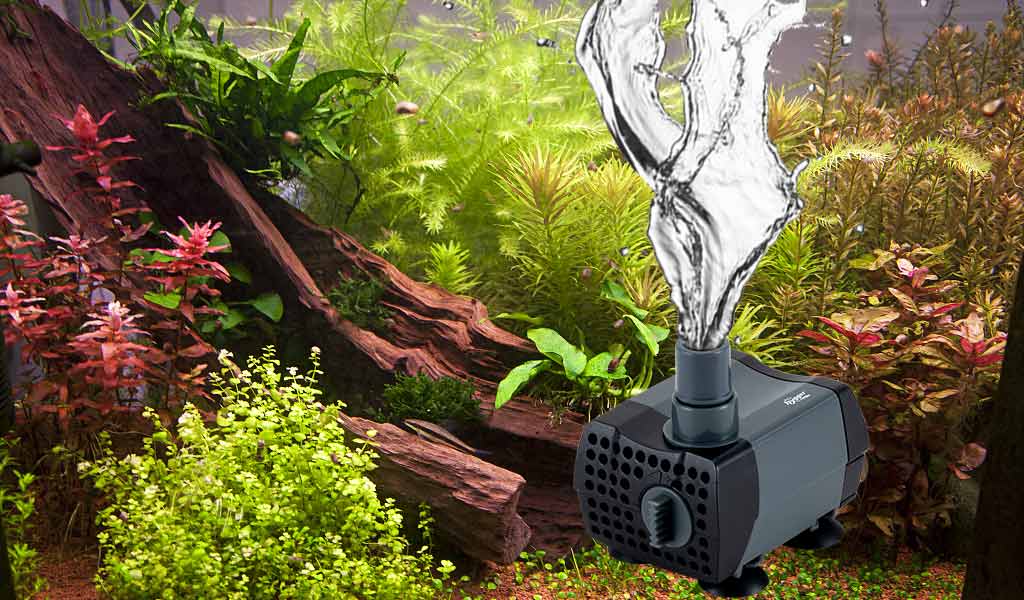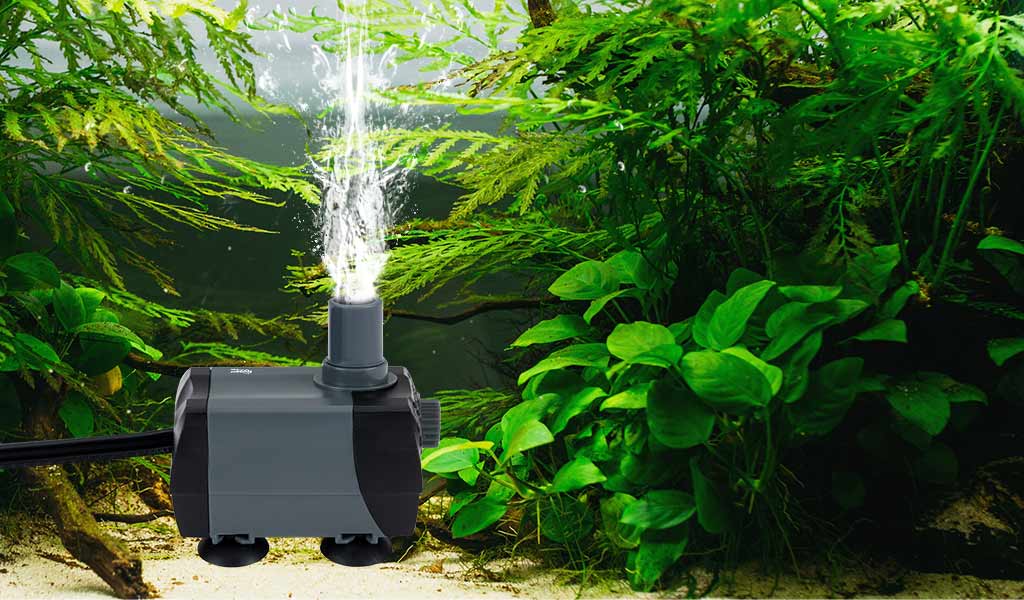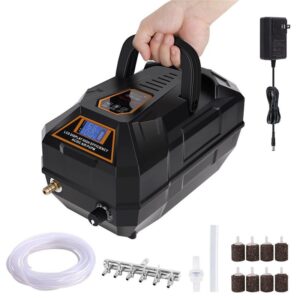Generally speaking, when people talk about aquariums, they often talk about how to maintain the overall water quality of the aquarium. The submersible water pump is a good way to solve water quality problems. But some newbies may feel unfamiliar with the name and have no idea what a submersible water pump is and what it does. If you are one of those people and have a strong curiosity and interest in the submersible water pump, then why not read the article?
Content Table
What are aquarium submersible water pumps?
The submersible water pump is a device that drives water into filters, also known as a water pump, and must be completely submerged to be effective. Prices will vary and are based on the size and flow rate of your aquarium. You can choose the type of pump you want by knowing the flow rate you require and your budget.

There are a variety of features available in the submersible water pump, including timers and gages, which allow you to control the flow and noise of the water. You can also find pumps with LED lights or other decorative features. A submersible pump for an aquarium can also be used to provide lighting. Some water pumps can also be equipped with timers or wave controls. Some models even have a controller built in.
The submersible water pump is capable of circulating water in the aquarium and cleaning dirt from the water. They also have filters to help maintain the water quality. And because they’re fully submersible, they are easy to install. Some pumps even have a built-in filtration system.
You should purchase an aquarium water pump based on the size of your fish tank and the surrounding area. The size of the pump must be chosen carefully, as well as the plumbing and filtration system inside. The more water that needs to be pumped, the larger the power required. The new generation of pumps is capable of handling more tasks than ever, and many of them include extra hardware that makes them more versatile.
They are rated by flow rate and per gallon. It is best to match the information to the size of your aquarium, as it will be the most effective method for choosing the right pump. You may want a larger one if you have extra items inside the tank, like plants.

How many hours can a water pump run in an aquarium?
A submersible water pump needs a constant source of fresh water to keep the motor cool and running at its optimal temperature. If the water level drops below the pump’s impeller, the motor will shut down and will likely burn out. However, if you have a pump that’s sized properly, you shouldn’t have to worry about it running constantly all day. If the pump is in a sump, you can set it to run every 15 minutes or so, depending on the water level in your tank.
While dry running may not affect the power of a pump, it can damage the impeller and the rear housing. Dry running is especially dangerous since it can damage seals and cause the pump to burn up or fail. However, this damage can easily be remedied by simply drilling out the impeller. While it’s a relatively simple procedure, it’s still not a good idea to leave your pump unattended for too long.
Besides running constantly, a water pump should also be fully submerged. Running the pump without water can cause overheating, melting, or even fusion of the impeller, which isn’t good for your submersible pump’s performance. When it’s in the water, it can run for up to 8 hours per day.

What kind of fish tank need a water pump?
Before installing a water pump in your aquarium, you must first decide which type of aquarium you have.
Adding a water pump to your aquarium can also help improve circulation. For example, a 55-gallon tank may have dead spots, or low circulation, because the water flow is concentrated near the filter and does not reach the farthest side of the aquarium. Furthermore, plants and decor may block the water flow from reaching the farthest corner, which may result in decreased oxygen levels and outbreaks of blue-green algae.
A water pump can be very useful in larger setups, but not every tank needs one. When choosing a water pump, consider the GPH (gallons per hour) of the tank. A low GPH will not be efficient at providing circulation and an excessively large one may force water out of the tank. It’s important to choose a water pump that’s the right size for your fish tank to avoid buyer’s remorse.
In addition to a water pump, you’ll also need a substrate. You can choose a substrate with glass or plastic pieces, or you can use sand and gravel as a substrate. Glass and plastic materials are both good choices, but make sure to check out the recommended size for your tank. A gravel-based substrate will help your fish live more happily and prevent algae from forming on the sides of the tank.
Another way to determine whether you need a water pump is to measure the volume of your aquarium. If you have a 70-liter tank, it will weigh more than 14 stones when full. This is due to the roots of plants that prevent the water from flowing across the aquarium’s plate. Smaller fish tanks will not need a water pump, but if you have a large aquarium, it may be necessary to install a larger water pump.
Once you have chosen the type of pump, the next step is to decide where to install it. You can either install it higher or lower than the top of your fish tank, depending on your preference. Make sure to cut the airline tubing between your sponge filter and the aquarium device. Then, attach the check valve. The check valve flapper should be facing the air pump. This flapper prevents air flow when the air pump is working, which prevents water from escaping through the airline tubing.

Choosing the right water pump for your aquarium
When deciding which aquarium pump is right for your fish tank, the first thing to do is decide how much water you will need to move. Some fish require high water flow, while others need less. You can do a bit of research and find out what your fish like. Then, choose a water pump that will give them the best flow rate possible. If you have a plan to add plants to your tank, you can also opt for an air stone. However, these don’t produce the same amount of water movement as a water pump.
You should also consider the size of your aquarium. A 40 GPH aquarium pump isn’t necessary for a 20-gallon tank, and it will cost you more money. Your budget should be a determining factor in your choice. If you’re on a tight budget, you may have to settle for a cheap one, but it’s not worth the sacrifice in quality. Instead, look for the most affordable products that will fit the size of your tank perfectly.
When choosing a water pump, you should know how much water your fish tank will require. The most common types of pumps are submersible and in-line. Submersible aquarium pumps run entirely underwater, while in-line pumps are connected to an inlet and outlet hose. In-line pumps are typically more powerful than submersibles, so they are a good option for larger aquariums.
A good way to determine which water pump will be best for your fish tank is to check its GPH rating. A water pump with a higher GPH means that your fish will receive a greater flow of clean, oxygenated water. You should also consider the head height of your tank when choosing a water pump. This is because the latter will affect the flow of water in your tank. You’ll also have a better idea of which water pump to buy after comparing prices.
Submersible pumps are usually mounted below the water line and have inline heaters. Submersible pumps are easy to install and can pump a large amount of water. Some models have a built-in heater to keep the water at a constant temperature. Submersible pumps are more expensive than inline pumps, but are typically more environmentally friendly. They will give your fish clean water and flow water every two hours.
The size of the water pump you buy is dependent on the GPH of the water that you want to lift. Fortunately, most pumps have a chart that combines the two measurements to help you choose the right one. However, this chart is usually only for the Active Aqua Submersible Pump. Every manufacturer has its specific chart. The chart you see may not be accurate for your specific fish tank. If the GPH and head height aren’t exactly right, your fish may die.



Leave a comment